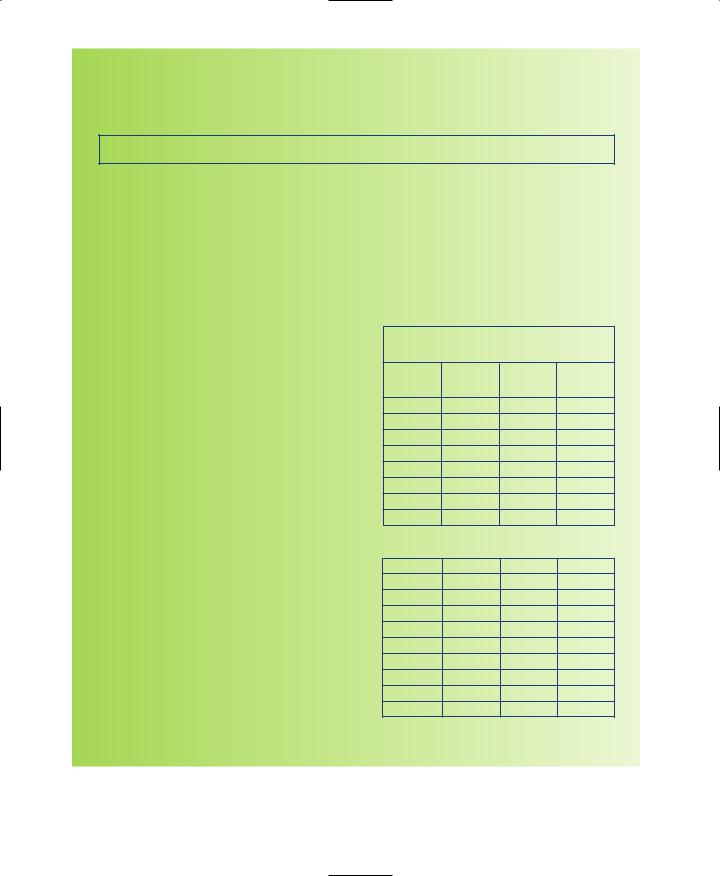
- •CONTENTS
- •PREFACE
- •Content—Benefits for Students
- •Content—Benefits for Instructors
- •Features of the Book for Students and Instructors
- •Supplementary Materials
- •Acknowledgments
- •What Is Hospitality Management?
- •The Manager’s Role in the Hospitality Industry
- •Why Study in a Hospitality Management Program?
- •Planning a Career
- •Employment as an Important Part of Your Education
- •Getting a Job
- •Employment at Graduation
- •The Outlook for Hospitality
- •Summary
- •Managing Change
- •Demand
- •Supply
- •Workforce Diversity
- •The Impact of Labor Scarcity
- •Summary
- •The Varied Field of Food Service
- •The Restaurant Business
- •The Dining Market and the Eating Market
- •Contemporary Popular-Priced Restaurants
- •Restaurants as Part of a Larger Business
- •Summary
- •Restaurant Operations
- •Making a Profit in Food Service Operations
- •Life in the Restaurant Business
- •Summary
- •Chain Restaurant Systems
- •Independent Restaurants
- •Franchised Restaurants
- •Summary
- •Competitive Conditions in Food Service
- •The Marketing Mix
- •Competition with Other Industries
- •Summary
- •Self-Operated Facilities
- •Managed-Services Companies
- •Business and Industry Food Service
- •College and University Food Service
- •Health Care Food Service
- •School and Community Food Service
- •Other Segments
- •Vending
- •Summary
- •Consumer Concerns
- •Food Service and the Environment
- •Technology
- •Summary
- •The Evolution of Lodging
- •Classifications of Hotel Properties
- •Types of Travelers
- •Anticipating Guest Needs in Providing Hospitality Service
- •Service, Service, Service
- •Summary
- •Major Functional Departments
- •The Rooms Side of the House
- •Hotel Food and Beverage Operations
- •Staff and Support Departments
- •Income and Expense Patterns and Control
- •Entry Ports and Careers
- •Summary
- •The Economics of the Hotel Business
- •Dimensions of the Hotel Investment Decision
- •Summary
- •The Conditions of Competition
- •The Marketing Mix in Lodging
- •Product in a Segmented Market
- •Price and Pricing Tactics
- •Place—and Places
- •Promotion: Marketing Communication
- •Summary
- •The Importance of Tourism
- •Travel Trends
- •The Economic Significance of Tourism
- •The United States as an International Tourist Attraction
- •Businesses Serving the Traveler
- •Noneconomic Effects of Tourism
- •Summary
- •Motives and Destinations
- •Mass-Market Tourism
- •Planned Play Environments
- •Casinos and Gaming
- •Urban Entertainment Centers
- •Temporary Attractions: Fairs and Festivals
- •Natural Environments
- •On a Lighter Note. . .
- •Summary
- •Management and Supervision
- •The Economizing Society
- •The Managerial Revolution
- •Management: A Dynamic Force in a Changing Industry
- •What Is Management?
- •Summary
- •Why Study Planning?
- •Planning in Organizations
- •Goal Setting
- •Planning in Operations
- •The Individual Worker as Planner
- •Long-Range Planning Tools
- •Summary
- •Authority: The Cement of Organizations
- •Departmentalization
- •Line and Staff
- •Issues in Organizing
- •Summary
- •Issues in Human-Resources Management
- •Fitting People to Jobs
- •Recruiting
- •Selection and Employment
- •Training
- •Retaining Employees
- •Staff Planning
- •Summary
- •The Importance of Control
- •Control and the “Cybernetic Loop”
- •Tools for Control
- •Summary
- •Leadership as Viewed by Social Scientists
- •Why People Follow
- •Leadership Theories
- •Communication
- •The Elements of Leading and Directing
- •Developing Your Own Leadership Style
- •Summary
- •A Study of Service
- •Rendering Personal Service
- •Managing the Service Transaction
- •How Companies Organize for Service
- •Summary
- •INDEX

584Chapter 18 Staffing: Human-Resources Management in Hospitality Management
performance was excellent or good when compared to nondisabled workers. Since the passing of the ADA in 1993, many businesses within the restaurant sector have been extremely proactive at hiring and training disabled workers. Certain restaurants have worked hard at hiring from this group and received tremendous recognition for their efforts. Of the 27 employees at the Wilson Street Grill in Madison, Wisconsin, over one-third have some sort of disability. The owners indicate that they haven’t changed their high standards and continue to require tests and a probationary period for all employees. The organization has simply been successful matching employees with the right job in the restaurant.1
Recruiting
Once we know what kind of people we want for each job we’ve identified, we must try to attract a pool of applicants that permits us to select the best-qualified. This activity is known as recruiting. Indeed, we will shortly argue that, in the face of labor shortages, it has become as necessary to segment the labor market as it has been to target the appropriate customer group. The major sources of prospective employees are the operation itself (the internal source) and various outside sources. Each has its
special strengths and problems.
It is interesting to see what steps are taken in the search process when there is a severe labor shortage such as the one we mentioned earlier. What one company did was to appoint a special task force of human resources and operations people to lead a crash recruiting program in the area. The task force compared the company’s operating, pay, and human-resource practices with those of its competitors. As a result, wages and benefits were adjusted as appropriate, an incentive program was introduced for suggestive selling, and the employee food discount and vacation programs were improved. Moreover, the task force used mobile recruiting vans and developed a reward program for referrals of new employees by those already on staff.
As you can see, recruiting involved thinking through the job the company had to offer in much the same way it might have looked at a product for sale. Increasingly, employers are seeing themselves as having, in effect, “jobs for sale,” with their prospective employees as their customers. Day in and day out, crisis or not, recruiting follows the same general pattern.
INTERNAL SOURCES
Recruiting via internal sources can be accomplished in a variety of ways. Employees often recommend their friends and relatives for work. Many hotel and food service employers pay a bonus to employees who refer applicants who take a job and stay

Recruiting 585
in it for a specified period of time. Hiring people who come with the recommendation of reliable employees increases the chances that the new employee will fit in with the existing organization. Because the person recommending the new employee has to go on record not only with the boss but also with fellow employees, he or she is likely to make recommendations cautiously. Besides, the current employee will have to work with the new hire, too.
A second internal source is the pool of former employees. Some may have left to raise children or pursue further schooling; others may have changed employers for what looked like a better opportunity. Because former employees are a known quantity—and because they know the company and its practices—they have an advantage over a new applicant. Many firms make a practice of using former employees, particularly servers, on a part-time basis for parties and banquets or for an extra-busy day such as Mother’s Day or a football weekend.
Of course, when trying to fill higher-level positions (supervisory and above), there is always the third source, which consists of current employees themselves. Some companies pride themselves on taking care of employees first by promoting from within. This practice will necessarily leave a vacant position at some level below the newly filled position, however, requiring the company to eventually search externally.
Although internal sources offer the advantages of a known quantity, these sources may not supply enough people in a tight labor market. If an operation requires a major addition to its workforce—for example, after expansion—these sources are often inadequate, and so the operation must look outside.
EXTERNAL SOURCES
The three major means of contacting employees via external sources are through traditional advertisements (such as in the newspaper), on-line recruiting (such as on Monster.com) and employment agencies. Also, some applicants walk in. Finally, operations that are organized by a union can call the hiring hall and ask that members be referred for employment.
Advertising. The strengths and weaknesses of advertising lie in the number of applicants it generally yields. In help-wanted ads, posted either online or in traditional print media, you direct your request to a large readership. People who read help-wanted ads are usually searching for a job or thinking of changing jobs. From this large number of readers, a good number of people are likely to apply. Thus, the employer can choose those who appear to have the best qualifications from among a large pool of applicants. When several positions must be filled or when a new operation is being started, the large number of applicants offers obvious advantages.

586 |
Chapter 18 Staffing: Human-Resources Management in Hospitality Management |
On the other hand, those large numbers can be a disadvantage. Dealing with a great number of applicants is time-consuming. Each applicant submits an application
(and in some cases, must be told how to complete it), and then each application must be processed. These clerical duties are compounded by management’s commitment to interview the applicants, which also takes a great deal of time. Because applicants are members of the public—that is, members of the community from which the customers come—each applicant must receive courteous attention, or management risks losing their patronage and that of their relatives and acquaintances. Because of the time commitment necessary, many employers advertise jobs only if they have a number of positions to fill or if the labor market is especially tight.
Some firms have found job fairs and open houses an effective approach to mass recruiting. Job fairs provide a neutral atmosphere where job seekers and employers can meet informally. The setting lends itself to brief, informational exchanges that also offer the employer an opportunity to screen applicants and call back those who seem interesting. An open house functions in much the same way but gives the company an opportunity to acquaint applicants with its operation.
Online Recruiting. This medium is becoming the preferred method for many hospitality companies as it allows for prescreening and is an efficient means of sorting through large numbers of applications. Furthermore, it enables efficient matching of applicants and companies. Companies typically use two means of online recruiting—job boards or their own employment Web sites. Popular job board sites include Monster.com (and MonsterTRAK which is specific for colleges and universities), CareerBuilder.com, Hotjobs.com, Flipdog.com, Idealist.org (for nonprofits), Simplyhired.com, and Hotelscareers.com. From a company perspective, the advantage of a job board is that it provides a greater reach than what other media advertising might provide. Similarly, for students, it allows them to research companies (and jobs) outside of their local areas.
A more targeted type of job board includes sites such as MonsterTRAK which, in addition to offering specialized service to students at individual colleges and universities, has special features that allow students to connect with alumni.
More and more companies are developing their own sites, including many of the larger hospitality companies such as Marriott, Hyatt, and McDonald’s.
Both recruiters and campus representatives continue to remind students that as efficient as online sites can be, students still have to be proactive in their job searches. It is not enough to simply post a résumé and sit back and wait for a company to contact you.
Employment Agencies. Each state maintains employment offices in or accessible to all communities in the state. The agencies are operated with tax revenue; thus, they

Selection and Employment |
587 |
require no placement fee from either the employer or the employee. Because people must register with the employment service when they are out of work in order to qualify for unemployment compensation, this office remains constantly in touch with job seekers.
Many employers make it a point to become personally acquainted with the state employment office’s manager and counselors. If the employment office staff knows an employer’s applicant standards, the office can save a great deal of time by screening applicants for the employer. Then, too, these staff people are often contacted by people they have helped before who are considering a change of employer. The experienced counselor often helps employers make hiring choices, and the counselor’s recommendation can also influence a capable employee’s choice of employer.
Private employment agencies charge a fee, which is sometimes paid by the employer. Although some private agencies handle hourly personnel in the hospitality industry, the authors’ experience suggests that the greatest users of private employment agencies in our field are supervisory and executive personnel.
SEGMENTING THE EMPLOYEE MARKET
Each segment—teens, working mothers, or older workers—has special needs. For teens, part-time and weekend work is important. Many mothers are interested in working while their children are in school. Older workers have quite different perceptions of the hiring process and do not necessarily respond well to the same advertising media as others. Rather, they are more likely to respond to specialized employment organizations and state, city, and local agencies. They, too, prefer part-time employment and flexible scheduling.
In today’s workforce, an educated and often discriminating employee decides where to work. Under the circumstances, recognizing recruiting as more like selling just makes sense.
Selection and Employment
Until this point, we have explored ways to determine what kinds of employees we need and ways to contact potential employees. We turn our attention now to the process of selecting and “breaking in” new workers. The first step, employee selection, is followed by orientation and then by training. Each step is crucial to develop-
ing productive workers.

588 |
Chapter 18 Staffing: Human-Resources Management in Hospitality Management |
SELECTION
Rich Melman’s Lettuce Entertain You Enterprises (LEYE) has one of the hospitality industry’s lowest turnover rates (47 percent). Suzie Southgate-Fox, the company’s senior vice president for human resources, sums up the secret of Lettuce’s success: “We hire carefully. We look for people with things we can’t teach.” She uses words such as “aware, caring, sweet, giving, team player” to describe the traits they want.2
The selection process involves gathering, classifying, and analyzing information available from several sources. An application often tells more than an applicant realizes. For instance, if an applicant cannot follow the simple directions on the form, a manager is entitled to wonder if he or she will be able to learn the job. If an applicant does not bother to fill it out completely, he or she may be unwilling to do assigned work. If the open position—say, that of a desk clerk—involves writing, an application filled out in an illegible scrawl may disqualify the applicant.
A properly completed application should account for the applicant’s work over the period specified on the application. Any blanks or “extended vacations” should be carefully checked. (The cashier you’re about to hire may have spent some time in jail for embezzlement.)
The application form usually helps screen out applicants, allowing management to pinpoint the ones it is interested in inviting for an interview. The application can even help start the interview. During the first part of the interview, an interviewer should clarify any ambiguous information on the application. The interviewer will also want to give the applicant information about the company and the job. This interchange helps most interviewers begin the process of sizing up the applicant, determining what kind of a person he or she is and how he or she would get along with the present employees. Interviewing should also focus on the applicant’s background and indicate whether he or she is, in fact, qualified (or what is sometimes a bigger problem, overqualified) for the job and whether he or she would actually like the job and be likely to continue in it. Two forms that suggest one company’s approach to summarizing an interview and an applicant evaluation are shown in Figures 18.4 and 18.5.
Applicants should list their references and former employers on the application blanks, and these entries should be checked. Most references are selected because the applicant thinks he or she will receive a good review, and so it is important to check with the employers to verify the employment history and, where possible, to learn how the applicant performed. At the end of the interview, the applicant should be told when he or she will be contacted regarding employment or a follow-up interview (depending upon company policy). If several people are being considered, an applicant should be told when a decision is to be made. Those applicants who are not hired should be notified promptly so they can continue their search for employment. Most employers

Selection and Employment |
589 |
TO: ____________________________________________________
FROM: _________________________________________________
INTERVIEW REPORT
DATE OF THIS
NAME OF APPLICANT: ___________________________________________ INTERVIEW: __________________
ADDRESS _______________________________________________________ PHONE ______________________
CANDIDATE FOR: ________________________________________________________________________________
(Job Title)
INTERVIEWER: __________________________________________________________________________________
PLEASE REPORT YOUR INTERVIEW IMPRESSIONS BY CHECKING THE ONE MOST APPROPRIATE BOX IN EACH AREA.
1. |
APPEARANCE |
|
|
|
|
Very untidy; |
Somewhat careless |
Satisfactory |
Good taste in |
Unusually well |
|
|
poor taste |
about personal |
personal |
dress; better- |
groomed; very |
|
in dress. |
appearance. |
appearance. |
than-average |
neat; excellent |
|
|
|
|
appearance. |
taste in dress. |
2. |
FRIENDLINESS |
|
|
|
|
Appears very |
Approachable; |
Warm; friendly, |
Very sociable |
Extremely |
|
|
distant and |
fairly friendly. |
sociable. |
and outgoing. |
friendly and |
|
aloof. |
|
|
|
sociable. |
3. |
POISE, STABILITY |
|
|
|
|
Ill at ease; |
Somewhat tense; |
About as poised |
Sure of himself; |
Extremely well |
|
|
is jumpy |
is easily irritated. |
as the average |
appears to like |
composed; appar- |
|
and appears |
|
applicant. |
crises more than |
ently thrives |
|
nervous. |
|
|
average person. |
under pressure. |
4. |
PERSONALITY |
|
|
|
|
Unsatisfactory |
Questionable for |
Satisfactory for |
Very desirable |
Outstanding for |
|
|
for this job. |
this job. |
this job. |
for this job. |
this job. |
5. |
CONVERSATIONAL ABILITY |
|
|
|
|
Talks very |
Tries to express |
Average |
Talks well and |
Excellent |
|
|
little; ex- |
himself but does |
fluency and |
to the point. |
expression; |
|
presses him- |
fair job at best. |
expression. |
|
extremely fluent; |
|
self poorly. |
|
|
|
forceful. |
6. |
ALERTNESS |
|
|
|
|
Slow to catch |
Rather slow; |
Grasps ideas |
Quick to under- |
Exceptionally |
|
|
on. |
requires more |
with average |
stand; perceives |
keen and alert. |
|
|
than average |
ability. |
very well. |
|
|
|
explanation. |
|
|
|
|
|
|
|
|
(Continued) |
Figure 18.4
Analysis of requirements for a food service director.

590 |
Chapter 18 Staffing: Human-Resources Management in Hospitality Management |
7. INFORMATION ABOUT GENERAL WORK FIELD |
|
|
||
Poor knowledge |
Fair knowledge |
Is as informed |
Fairly well in- |
Has excellent |
of field. |
of field. |
as the average |
formed; knows |
knowledge of the |
|
|
applicant |
more than aver- |
field. |
|
|
|
age applicant. |
|
8. EXPERIENCE |
|
|
|
|
No relationship |
Fair relation- |
Average amount |
Background very |
Excellent back- |
between appli- |
ship between |
of meaningful |
good; consider- |
ground and |
cant’s back- |
applicant’s |
background and |
able experience. |
experience. |
ground and job |
background |
experience. |
|
|
requirements. |
and job |
|
|
|
|
requirements. |
|
|
|
9. DRIVE |
|
|
|
|
Has poorly |
Appears to set |
Appears to have |
Appears to |
Appears to set |
defined goals |
goals too low and |
average goals; |
strive hard; has |
high goals and to |
and appears to |
to put forth little |
puts forth aver- |
high desire to |
strive incessantly |
act without |
effort to achieve |
age effort to |
achieve. |
to achieve these. |
purpose. |
these. |
reach these. |
|
|
10. OVERALL |
|
|
|
|
Definitely |
Substandard. |
Average. |
Definitely above |
Outstanding. |
unsatisfactory. |
|
|
average. |
|
|
1st INTERVIEW |
|
|
|
THIS IS: |
2nd INTERVIEW |
|
|
|
|
3rd INTERVIEW |
|
|
|
Figure 18.4
Continued.
maintain a file of applications from people who were not hired. Thus, a person not chosen at one time may be contacted later. (Incidentally, a file like this helps establish that management has followed fair-employment practices.)
Although the object of the selection process is to find the right people, in part that means avoiding the wrong people. One group most employers want to avoid is people who use drugs. Estimates of the proportion of drug users range as high as 30 percent of the workforce—and 75 percent of drug users use drugs on the job, so this is not a small problem. Experience indicates that drug users have five times as many workers’ compensation cases and draw three times as much in health claims, thus impacting insurance premiums unfavorably. Absenteeism among drug users is two and a half times that of employees who do not use drugs, and people with this problem are 25 percent less productive than the rest of the workforce. Accordingly, many employers have begun to use preemployment drug testing as a means of excluding

Applicant __________________________________________________________ |
SUMMARY |
||||
Job considered for _____________________________ |
|
APPLICANT EVALUATION |
|||
Grade ____________ |
CONFIDENTIAL |
||||
|
|
|
|
|
|
Evaluated by: __________________________________ |
Date _____________ |
|
|||
Rating |
Matches |
Exceeds |
|
Below |
Recommend |
Overall: |
Requirements |
Requirements |
Requirements |
Hire |
|
Major Strong Characteristics
_________________________________________________________________________
____________________________________________________________________________________________
____________________________________________________________________________________________
Major Weak Characteristics
_________________________________________________________________________
____________________________________________________________________________________________
____________________________________________________________________________________________
FACTOR EVALUATIONS FOR THIS POSITION |
Check |
The Applicant in Relation |
||
See Management Employment Program |
||||
|
to This Position |
|
||
for definitions. |
|
Almost |
Fails |
|
|
|
|||
SKILLS, KNOWLEDGE, ABILITIES |
Matches |
Matches Exceeds |
to Meet |
|
|
|
|
||
Appearance and presentation |
|
|
|
|
Education |
|
|
|
|
Mental ability |
|
|
|
|
Mobility |
|
|
|
|
Experience |
|
|
|
|
Physical condition |
|
|
|
|
Special skills and knowledge |
|
|
|
|
Relationships background |
|
|
|
|
HABITS, AMBITIONS, DRIVES |
|
|
|
|
Leadership |
|
|
|
|
Perseverance |
|
|
|
|
Stability |
|
|
|
|
Self-reliance |
|
|
|
|
Energy |
|
|
|
|
Maturity |
|
|
|
|
Ability to get along with others |
|
|
|
|
Need for income |
|
|
|
|
Need for status and power |
|
|
|
|
Need to serve |
|
|
|
|
SFS 0121-0567 |
|
|
|
|
Figure 18.5
Applicant evaluation form.
591

592Chapter 18 Staffing: Human-Resources Management in Hospitality Management
these undesirable prospects.3 Marriott, Houston’s, and Disney are just a few of the hospitality companies that have earned strong reputations for their selection processes.
ORIENTATION
It’s an old saying—and a true one—that first impressions are lasting impressions. It is surprising, then, how often new employees are told to sign some papers, given directions to the locker room, and then promptly forgotten. Such casual procedures destroy the golden opportunity to start a new employee off on the right foot. Common sense should suggest that the new employee be enthusiastically and cheerfully introduced to the operation, to fellow workers, and to the new job. Orientation presents companies with that very opportunity.
Ritz-Carlton puts heavy emphasis on orientation of new employees because it is the company’s experience that the first three or four days are crucial in determining the outlook an employee will have in his or her work. It is not a coincidence that many successful hospitality companies have adopted this same attitude toward orientation.
The Operation. Your restaurant, hotel, or dietary department is old ground to established employees. However, it is unmapped territory to a newcomer. For this reason, a guided tour by a member of management helps make an employee’s first day comfortable. Basic information, such as where the employees enter the building, where and when smoking is permitted, and where personal belongings are kept, should be provided. Some employees report spending a very uncomfortable first day because they were too embarrassed to ask strangers directions to the restrooms.
Are you proud of your operation? Are there certain dining rooms that are especially nice, certain views especially attractive? Let the newcomer share in these high points, too.
Certainly, a part of this orientation should be a statement of the standards of the operation with regard to both quality of product and service and personal conduct and hygiene. Such a statement should be made in a friendly way by a member of management, and it may also be presented to the new employee in the form of an orientation handbook. Such a postinterview conversation also gives management an opportunity to restate its policies on wages, fringe benefits, working conditions, days off, and so forth, as well as to make sure any questions the new employee may have are answered.
Fellow Workers. Don’t assume a new worker is a gregarious person who quickly strikes up friendships. Introduce the new employee to the individuals in the work group and to others with whom he or she will come into contact. Thus, for instance, the host or hostess should introduce a new server not only to the other servers but to cooks, pantry workers, and dishwashers as well.
